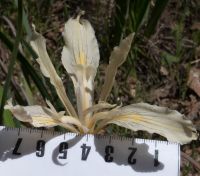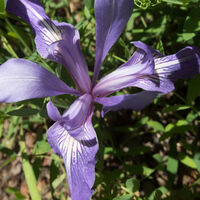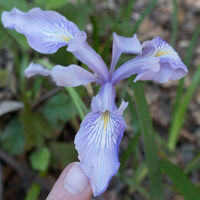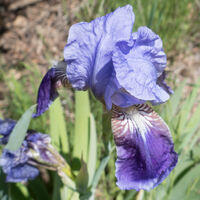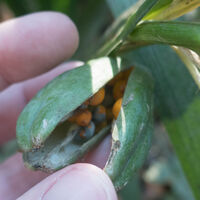irises
genus Iris
Member of
iris family (family Iridaceae)
monocots (class Liliopsida)
flowering plants (subphylum Angiospermae)
Except for old historical records and extremely rare examples that I don't expect to encounter, there are no other wild species of this genus in the bay area.
iNaturalist’s Seek app often suggests “oregon iris (Iris tenax)“, but it is not naturalized in the bay area.
Key features:
- perianth tube shape and length (measured from base of stamens to top of ovary [which can be hard to determine])
- basal leaf width
- cauline leaves similar to basal leaves or to bracts [spathes, or non-spathes?] (short, bract-like, inflated, and overlapping with only the tips free)
- stigma shape
- spathes opposite or alternate (the spathes are the lowest bracts when there is more than one flower per inflorescence)
Parts of an iris labeled: one, two.
The perianth tube is measured from the base of the stamens to the top of the ovary. (How to measure iris parts starting on page 11.)
The leaves are narrower, straighter, glossier, and deeper green than wavy-leafed soap plant (Chlorogalum pomeridianum).
Perianth tube > 30 mm
Iris fernaldii
- perianth yellow, veined darker
- perianth tube 35–60 mm, narrow, gradually funnel-shaped distally
- stem unbranched, 20–40 cm
- basal leaves 6–8 mm wide
- 1–3 cauline leaves, similar to basal
- sepals 5–7 cm, 7–21 mm wide, elliptic, clawed
- petals 4–6 cm, 6–12 mm wide, elliptic
- ovary triangular
- style branches 30–50 mm, crests 13–17 mm, stigmas triangular
- rare; Santa Cruz range, south from Foothills
Iris macrosiphon
Warning: ID uncertain.
- perianth cream to gold-yellow or lavender to deep blue-purple, generally veined darker
- perianth tube 34–65 mm, abruptly inflated, bowl-like at top [there is no bowl]
- stem unbranched, 0–15 cm
- basal leaves 3–6 mm wide, base generally colorless
- 0–3 cauline leaves, similar to basal
- sepals 4–7 cm, 14–22 mm wide, widely elliptic, clawed, ± flared at base
- petals 4–7 cm, 6–11 mm wide, elliptic
- ovary triangular
- style branches 19–33 mm, crests 8–18 mm, stigmas triangular
- uncommon; open to partly shaded slopes in oak or pine woodland
Perianth tube < 30 mm
Stigmas triangular
Iris douglasiana
- perianth light to dark lavender, deep red-purple, or pale cream, veined purple
- perianth tube 10–24 mm, funnel-shaped
- stem generally branched, 15–50 cm
- basal leaves 10–22 mm wide
- bifacial, i.e. one side shiny, the other side dull
- 1–3 cauline leaves, similar to basal
- sepals 5–8 cm, 14–30 mm wide, obovate
- petals 5–7 cm, 10–18 mm wide, obovate
- ovary triangular, with nipple-like projection at tip
- style branches 30–50 mm, crests 9–20 mm, stigmas triangular
- var. major has a cross of characteristics between fernald’s iris (Iris fernaldii) and douglas iris (Iris douglasiana) [source]
Iris pseudacorus
- perianth generally bright yellow or cream with prominent brown veins, marks on sepals
- perianth tube 12–13 mm, barrel-shaped
- stem branched, 50–150 cm
- basal leaves 20–35 mm wide, stiff, midvein conspicuous
- 3–6 cauline leaves, similar to basal
- sepals widely oblanceolate, 5–8 cm, 35–50 mm wide
- petals obovate, clawed, 2–3 cm, 4–8 mm wide
- style branches < 25 mm, crests 7–10 mm, stigmas rounded
- Jasper, Marin, Mt. Tam; pond margins, estuaries
Stigmas 2-lobed
Iris longipetala
- perianth lilac-purple, veined darker
- perianth tube 5–13 mm, funnel-shaped
- stem rarely branched, 30–60 cm
- basal leaf 5–11 mm wide
- 1–2 cauline leaves, bract-like for at least ⅔ stem length
- lowest bracts alternate (rarely opposite), 0.5–10 cm apart
- sepals 6–10 cm, 30–50 mm wide, obovate
- petals 5–9 cm, 15–21 mm wide, elliptic
- ovary rounded
- style branches 35–43 mm, crests 12–15 mm, stigmas 2-lobed
- scattered; moist, coastal prairie or open coastal forest
Iris foetidissima
- perianth pale yellow to brown, red-brown, or green, veined green or red-brown
- perianth tube 11–14 mm, constricted near ovary
- stem generally branched, 25–40 cm
- basal leaf 25–35 mm wide
- 2–4 cauline leaves, bract-like for at least ⅔ length, but also similar to basal especially near tip [huh?]
- lowest 2 bracts opposite
- sepals 3–5 cm, 18–20 mm wide, obovate
- petals 3–4 cm, 11–18 mm wide, narrowly obovate
- ovary triangular
- style branches 22–30 mm, crests 5–8 mm, stigmas 2-lobed
- rare; damp areas in light shade
Toxicity of flag, iris, snake lily (Iris spp.):
1 – Skin contact with these plants can cause symptoms ranging from redness, itching, and rash to painful blisters like skin burns.
3 – Ingestion of these plants is expected to cause nausea, vomiting, diarrhea and other symptoms that may cause illness but is not life-threatening.
5 observed taxons / 2 unobserved taxons / 1 key
Locations: Months: For more details, use advanced search.
Chris’s observations: 60 (23 are research grade)
Taxon info: iNaturalist – Calflora – Jepson eFlora – FNA
Bay Area species: iNaturalist – Calflora
